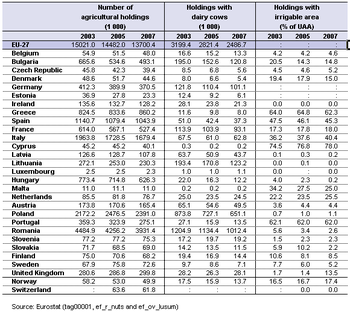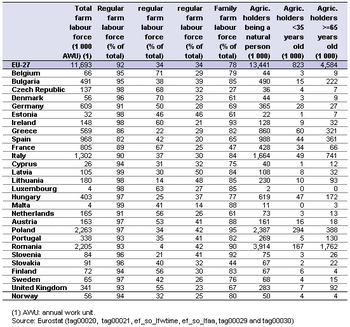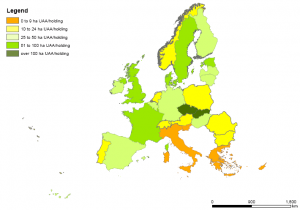Archive:Farm structure statistics
- Data from September 2009, most recent data: Further Eurostat information, Main tables and Database.
The structure of agriculture in the Member States of the European Union (EU) varies considerably. Among other factors, this reflects differences in geology, topography, climate and natural resources, as well as the diversity of regional activities, infrastructure and social customs. The 'Survey on the structure of agricultural holdings', also known as the Farm structure survey (FSS), helps assess the agricultural situation across the EU, monitoring trends and transitions in the structure of agricultural holdings, while also modelling the impact of external developments or policy proposals. This article presents some elements of the FSS.
Main statistical findings
Farm structure at EU level
There were 7.3 million commercial agricultural holdings in the EU in 2007, with a further 6.4 million small holdings (those below a threshold of 1 European size unit (ESU)). Almost half (48 %) of the small holdings in the EU, principally being subsistence in nature, were found in Romania. A little over one third of all the EU’s commercial agricultural holdings (of a size greater than 1 ESU) in the EU were in Poland (15.4 %) and Italy (18.9 %) in 2007. A further one third of commercial holdings were located in Spain (12.9 %), Romania (11.9 %) and Greece (9.7 %).
Among most Member States and across the EU-27 as a whole, there was a further steady decline in the number of agricultural holdings during the period between 2003 and 2007. In this four-year period, the number of agricultural holdings in the EU-27 declined by 1.3 million (or 8.8 %), of which almost half were commercial holdings. There were particularly fast structural changes in Estonia, where the number of holdings declined by more than one third (-36.7 %), as well as in Bulgaria (-25.9 %), Portugal (-23.4 %) and Hungary (-19.0 %).
The total farm labour force in the EU-27 was the equivalent of 11.7 million full-time workers, of which 9.0 million worked on commercial holdings. Agriculture remains very much a family-oriented activity in the majority of Member States; almost four fifths (78 %) of the total agricultural labour force were farm holders or members of their family. The main exceptions were Slovakia (44 %) and the Czech Republic (27 %), where there is a different ownership structure to the majority of Member States. Just over one third (34 %) of the regular agricultural labour force in the EU-27 was female, although in the Baltic Member States this share was closer to half, reaching 50 % in Latvia. There were relatively few (6.1 %) agricultural holders in the EU-27 under the age of 35 years, but a relatively large proportion (34.1 %) over the age of 65 years. Graph 1 indicates the proportion of farm holdings with other gainful economic activity.
Besides agricultural activity, other gainful activities were also conducted by about one in every ten (9.9 %) of the EU’s agricultural holdings in 2007, this proportion being slightly higher (13.5 %) among commercial holdings. A little over one quarter (27.6 %) of all holdings in Finland reported another gainful activity in 2007, with rates above 20 % also being recorded in Austria, Germany, Sweden, the United Kingdom, Denmark and France.
Two fifths (an estimated 40.1 %) of the total land area of the EU was utilised agricultural area in 2007. This proportion rose to two thirds (an estimated 66.5 %) of the land area of the United Kingdom, but was less than one tenth of the total in Sweden and Finland. Arable land (which includes cereals and other arable land) accounted for a little less than one quarter (24.2 %) of the total land area of the EU, with permanent grassland (which is composed of pasture, meadow and rough grazing) accounting for 13.2 % of the total land area. During the ten years through until 2007, the make-up of land use in the EU-27 did not change very much.
Farm structure by country, 2007 survey
As farm structure often has country-specific characteristics, reporting at the level of Member States makes excellent sense. Therefore a brief but nevertheless comprehensive insight into the farm structure in the Member States is provided in separate articles, one for each country (to be completed):
- Farm structure in Austria
- Farm structure in Belgium
- Farm structure in Bulgaria
- Farm structure in Cyprus
- Farm structure in Czech Republic
- Farm structure in Denmark
- Farm structure in Estonia
- Farm structure in Finland
- Farm structure in France
- Farm structure in Germany
- Farm structure in Greece
- Farm structure in Hungary
- Farm structure in Ireland
- Farm structure in Italy
- Farm structure in Lithuania
- Farm structure in Luxembourg
- Farm structure in Malta
- Farm structure in Norway
- Farm structure in Portugal
- Farm structure in Romania
- Farm structure in Slovakia
- Farm structure in Spain
- Farm structure in Sweden
- Farm structure in the United Kingdom
Farm structure evolution, 2003, 2005, 2007
Data sources and availability
A comprehensive Farm structure survey (FSS) is carried out by Member States every 10 years (the full scope being the agricultural census) and intermediate sample surveys are carried out three times between these basic surveys. The Member States collect information from individual agricultural holdings and, observing strict rules of confidentiality, data are forwarded to Eurostat. The information collected covers:
- land use;
- livestock numbers;
- rural development;
- management and farm labour input (including age, gender and relationship to the holder).
The survey data are then aggregated to different geographic levels (Member States, regions, and for basic surveys also districts) and arranged by size class, area status, legal status of holding, objective zone and farm type.
The basic unit underlying the FSS is the agricultural holding, a technical-economic unit under single management engaged in agricultural production. The FSS covers all agricultural holdings with a utilised agricultural area (UAA) of at least one hectare (ha) and those holdings with a UAA of less than 1 ha if their market production exceeds certain natural thresholds.
Built-up and related land comprises residential land, industrial land, quarries, pits and mines, commercial land, land used by public services, land of mixed use, land used for transport and communications, for technical infrastructure, recreational and other open land. Scattered farm buildings, yards and annexes are excluded. Some figures may refer to the closest year for which data is available (the limit being +/- one or two years before or after).
'Other gainful activity' is any activity other than that relating to farm work, including activities carried out on the holding itself (camp sites, accommodation for tourists, etc.) or that use its resources (machinery, etc.) or products (such as processing farm products, renewable energy production, etc.), and which have an economic impact on the holding. Other gainful activity is carried out by the holder, his/her family members, or one or more partners on a group holding.
The farm labour force is made-up of all individuals who have completed their compulsory education (having reached school-leaving age) and who carried out farm work on the holding under survey during the 12 months up to the survey day. The figures include the holders, even when not working on the holding, whereas their spouses are counted only if they carry out farm work on the holding. The holder is the natural person (sole holder or group of individuals) or the legal person (e.g. a co-operative or other institution) on whose account and in whose name the holding is operated and who is legally and economically responsible for the holding, i.e. the entity or person that takes the economic risks of the holding. For group holdings, only the main holder (one person) is counted. The regular labour force covers the family labour force (even those who were working accidentally on the holding) and permanently employed (regular) non-family workers. The family labour force includes the holder and the members of his/her family who carried out farm work (including all persons of retiring age who continue to work on the holding). One annual work unit (AWU) corresponds to the work performed by one person who is occupied on an agricultural holding on a full-time basis. Full-time means the minimum hours required by the national provisions governing contracts of employment. If these provisions do not explicitly indicate the number of hours, then 1 800 hours are taken to be the minimum (225 working days of eight hours each).
Context
Rural development policy aims to improve competitiveness in agriculture and forestry, improve the environment and countryside, improve the quality of life in rural areas and encourage the diversification of rural economies. As agriculture has modernised and the importance of industry and services within the economy has increased, so agriculture has become much less important as a source of jobs. Consequently, increasing emphasis is placed on the role farmers can play in rural development, including forestry, biodiversity, the diversification of the rural economy to create alternative jobs and environmental protection in rural areas. The FSS continues to be adapted to provide timely and relevant data to help analyse and follow these developments.
Further Eurostat information
Publications
- Agriculture – Main statistics 2005-2006((Pocketbook)
Main tables
- Agriculture (t_agri), see:
- Structure of agricultural holdings (t_ef)
Database
- Agriculture (agri), see:
- Structure of agricultural holdings (ef)
- Overview of agricultural holdings (ef_ov)
- Land Use (ef_lu)
- Livestock (ef_ls)
- Special interest topics (ef_so)
- Standard gross margin (SGM) coefficients used for typology (ef_tsgm)
- Standard output (SO) coefficients used for typology (ef_tso)
- Structure of agricultural holdings by region, main indicators (ef_r_main)
Dedicated section
Methodology/Metadata
- Structure of agricultural holdings [ESMS metadata file - ef_esms]
Other information
- Farm structure – Methodology of Community surveys
- Regulation 571/88 of 29 February 1988 on the organization of Community surveys on the structure of agricultural holdings between 1988 and 1997
- Commission Decision 85/377/EEC of 7 June 1985 establishing a Community typology for agricultural holdings
- Commission decision 115/2000 of 24 November 1999 relating to the definitions of the characteristics, the list of agricultural products, the exceptions to the definitions and the regions and districts regarding the surveys on the structure of agricultural holdings





